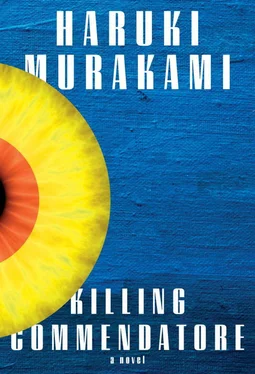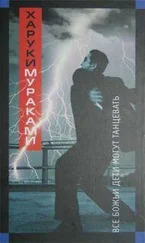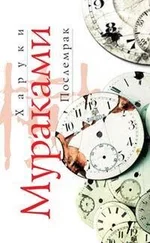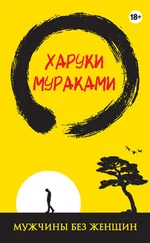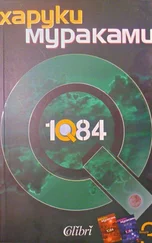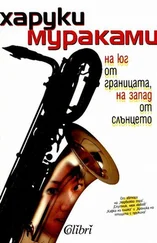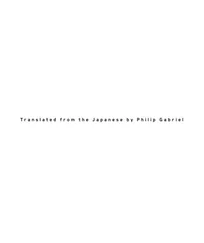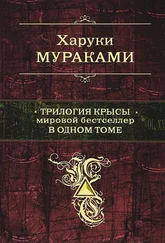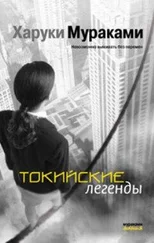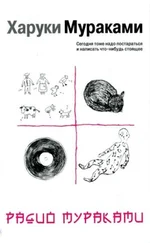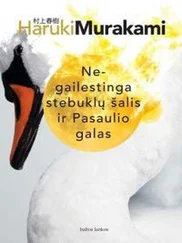I kept working until ten thirty. The sun had made a slow crawl to the midpoint in the sky, the gray clouds had broken into thin strands, driven away one after another beyond the mountains. No longer did water drip from the tips of the tree branches. I stepped back and examined the rough sketch I’d done from various angles. What I saw was the face of the man I’d remembered. Or rather the framework that should abide in that face. But there were a few too many lines. I needed to do some trimming. Subtraction was the order of the day. But that was for tomorrow. Best to end this day’s work here.
I put down the now shorter stick of charcoal, and washed my smudged hands in the sink. As I dried my hands with a towel, my eyes came to rest on the bell on the shelf in front of me, and I picked it up. I shook it, and the sound was terribly light, dry, and outdated. I couldn’t believe it was an enigmatic Buddhist implement that had been underground for ages. It sounded so different from what I’d heard in the middle of the night. No doubt the pitch black and stillness had added to the depth and clarity of the sound, and made it carry farther.
The question of who could possibly have been ringing that bell in the middle of the night remained an unsolved mystery. Though someone must have been down in the hole every night ringing it (sending out what had to be some kind of message), whoever it was had vanished. When we uncovered the hole, all that was there was this bell. The whole thing was baffling. I placed the bell back on the shelf.
—
After lunch I went outside and into the woods out back. I had on a thick gray hooded windbreaker, and paint-stained sweatpants. I followed the damp path to the small shrine, and walked around behind it. The thick board cover over the hole was piled with fallen leaves of different colors and shapes. Leaves soaked by last night’s rain. Since Menshiki and I had visited two days before, no one else seemed to have touched the cover. I wanted to make sure of that. I sat down on the damp stones, and, listening to the calls of birds overhead, I gazed for a while at where the hole was.
In the silence of the woods it felt like I could hear the passage of time, of life passing by. One person leaves, another appears. A thought flits away and another takes its place. One image bids farewell and another one appears on the scene. As the days piled up, I wore out, too, and was remade. Nothing stayed still. And time was lost. Behind me, time became dead grains of sand, which one after another gave way and vanished. I just sat there in front of the hole, listening to the sound of time dying.
What would it feel like to sit at the bottom of that hole, all alone, I wondered. Being shut away by oneself in a cramped dark space. Menshiki had even given up his flashlight and the ladder. Without the ladder, without someone’s help (specifically mine ) it would be nearly impossible to escape from there. Why did he have to go to the trouble of putting himself into such a predicament? Did being down in that dark hole remind him of his solitary time behind bars in Tokyo Prison? There was no way I could know that, of course. Menshiki lived his own life, in his own way.
I could say only one thing for sure. I would never be able to do that . Nothing scared me more than dark, confined spaces. Put me in a place like that, and I wouldn’t be able to breathe, I’d be so terrified. Even so, I was drawn to that hole. Drawn very strongly . So much so it felt like the hole was beckoning to me.
I sat next to the hole for a good half hour. Then I stood up and walked home through the sunlight that filtered down through the trees.
—
After two p.m. I had a call from Masahiko Amada. He had an errand to run near Odawara and wondered if he might drop by. Of course, I told him. I hadn’t seen him in a while. He drove up just before three. He brought a bottle of single-malt whiskey as a present. I thanked him. Good timing, since I’d almost run out of whiskey. As always he was stylishly dressed, neatly shaved, wearing glasses I’d seen before, with shell-rimmed frames. He looked nearly the same as he had in the past, though admittedly his hairline was beating a slow-motion retreat.
We sat in the living room and caught up. I told him how the landscapers had used heavy equipment to dig up the stone mound. How after that, a hole just under six feet in diameter had emerged. Nine feet deep, surrounded by a stone wall. A heavy lattice cover was over it, and when that was removed, all we found was an old Buddhist implement like a bell. He listened intently as I told him the story. But he didn’t say he wanted to see the hole. Or the bell.
“After that I take it you didn’t hear the bell at night?”
“I don’t hear it anymore,” I said.
“That’s great,” he said, sounding a bit relieved. “I can’t handle those kind of spooky things. I try to avoid them at all costs.”
“Let sleeping dogs lie?”
“Exactly,” Masahiko said. “I leave that hole up to you. Do whatever you like.”
I told him how now, for the first time in what seemed like forever, I had the urge to paint. How ever since I finished Menshiki’s portrait two days ago, it was like some blockage had been removed. I felt like I was discovering a new, original style, using portraits as a motif. I’d started the painting as a portrait, but what had eventually emerged was far from a conventional likeness. Even so, it was in essence still a portrait.
Masahiko wanted to see Menshiki’s portrait, but when I told him I’d already given it to him, he was disappointed.
“But the paint can’t be dry yet, can it?”
“He said he’d make sure it dries properly,” I said. “He seemed eager to have the painting as quickly as possible. I don’t know, maybe he was worried I might change my mind and not give it to him.”
“Hmm,” Masahiko said, impressed. “Do you have any new work, then?”
“I started on something this morning,” I said. “But it’s still just a charcoal sketch, so even if you saw it, it wouldn’t mean anything.”
“That’s okay. Would you mind showing it to me?”
I took him into the studio and showed him the sketch for The Man with the White Subaru Forester . It was just a rough sketch in charcoal, but Masahiko stood in front of the easel, arms folded, a hard look on his face.
“Interesting,” he said a little later, squeezing the words out between his teeth.
I was silent.
“It’s hard to tell how it’s going to develop, but it certainly does look like someone’s portrait. Like the root of a portrait. A root buried deep in the ground.” He was silent for a time.
“In a very deep, dark place,” he went on. “And this man—it is a man, right?—is angry about something? What is he blaming?”
“You got me. I haven’t got that far.”
“You haven’t got that far,” Masahiko repeated in a monotone. “But there really is a deep anger and sadness here. And he can’t spit it out. The anger is swirling around inside him.”
In college Masahiko was in the oil painting department, though to be blunt about it, he wasn’t known as a great painter. He was skilled enough, but his work lacked depth, something he himself admitted. He was, however, blessed with the skill of being able to instantly evaluate other people’s paintings. So whenever I felt stuck doing one of my own paintings, I’d ask his opinion. His advice was always accurate and impartial, as well as practical. And thankfully he had no sense of jealousy or rivalry. I guess this was part of his personality, something he was born with. I always could believe what he told me. He never minced words, but had no ulterior motives, so oddly enough even when his criticism was pretty scathing, I never felt upset.
Читать дальше
